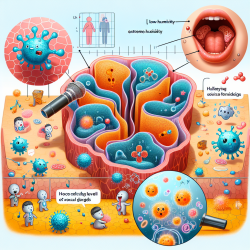Introduction
For speech-language pathologists, understanding the physiological changes that occur in the vocal folds due to environmental factors is crucial. Recent research titled Recurring exposure to low humidity induces transcriptional and protein level changes in the vocal folds of rabbits sheds light on how low humidity environments can significantly alter the vocal folds at a molecular level. This study, conducted on New Zealand White rabbits, mimics occupational exposure to low humidity, providing insights that can be translated to human contexts, particularly for professional voice users and children in school settings.
Key Findings from the Study
The study found that recurring exposure to low humidity (21.9% relative humidity) over 15 days led to significant transcriptional and proteomic changes in the vocal folds:
- Gene Expression Changes: There was a notable upregulation of MUC4 and SLC26A9, indicating a cellular stress response. These changes suggest that the vocal folds attempt to maintain homeostasis under dehydrated conditions.
- Protein Level Changes: The proteomic analysis revealed alterations in proteins associated with muscle structure, oxidative stress response, and protein chaperonin stress response. This indicates that low humidity can induce cellular stress at the vocal fold level.
Implications for Practitioners
Understanding these molecular changes is vital for practitioners aiming to improve voice therapy outcomes. Here are some actionable insights:
- Environment Monitoring: Ensure that therapy environments, especially in schools, maintain optimal humidity levels to prevent dehydration-related vocal fold stress.
- Hydration Strategies: Encourage regular hydration in children and voice professionals to counteract the effects of low humidity.
- Further Research: Practitioners should consider further research into the specific molecular pathways affected by dehydration to develop targeted therapeutic interventions.
Conclusion
This study provides compelling evidence that low humidity can significantly impact vocal fold health at a molecular level. For practitioners, these findings underscore the importance of environmental control and hydration in therapeutic settings. By integrating these insights, we can enhance therapeutic outcomes for children and professional voice users alike.
To read the original research paper, please follow this link: Recurring exposure to low humidity induces transcriptional and protein level changes in the vocal folds of rabbits.










